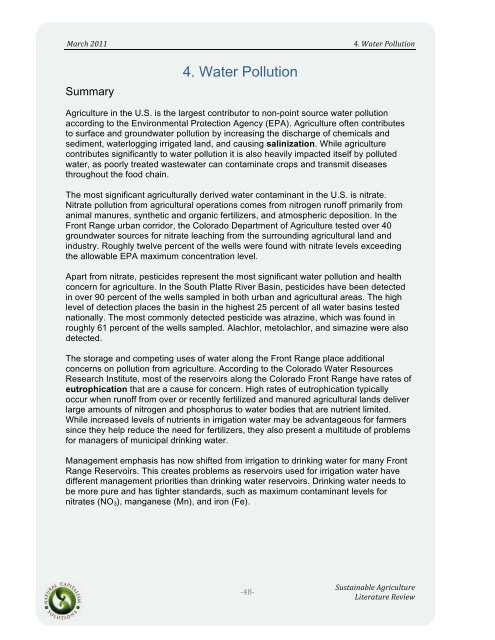Sustainable Agriculture Literature Review - Boulder County
Sustainable Agriculture Literature Review - Boulder County
Sustainable Agriculture Literature Review - Boulder County
Create successful ePaper yourself
Turn your PDF publications into a flip-book with our unique Google optimized e-Paper software.
! !!<br />
"#$%&!'())!!!!!!!! !!!!!!!!!!!!!!!!!!!!!!!!!!!!!!!!!!!!!!!!!!!!!!!!!!!!!!!!!!!!!!!B=!@#-2$!CD11+-.D/!<br />
Summary<br />
!<br />
4. Water Pollution<br />
<strong>Agriculture</strong> in the U.S. is the largest contributor to non-point source water pollution<br />
according to the Environmental Protection Agency (EPA). <strong>Agriculture</strong> often contributes<br />
to surface and groundwater pollution by increasing the discharge of chemicals and<br />
sediment, waterlogging irrigated land, and causing salinization. While agriculture<br />
contributes significantly to water pollution it is also heavily impacted itself by polluted<br />
water, as poorly treated wastewater can contaminate crops and transmit diseases<br />
throughout the food chain.<br />
The most significant agriculturally derived water contaminant in the U.S. is nitrate.<br />
Nitrate pollution from agricultural operations comes from nitrogen runoff primarily from<br />
animal manures, synthetic and organic fertilizers, and atmospheric deposition. In the<br />
Front Range urban corridor, the Colorado Department of <strong>Agriculture</strong> tested over 40<br />
groundwater sources for nitrate leaching from the surrounding agricultural land and<br />
industry. Roughly twelve percent of the wells were found with nitrate levels exceeding<br />
the allowable EPA maximum concentration level.<br />
Apart from nitrate, pesticides represent the most significant water pollution and health<br />
concern for agriculture. In the South Platte River Basin, pesticides have been detected<br />
in over 90 percent of the wells sampled in both urban and agricultural areas. The high<br />
level of detection places the basin in the highest 25 percent of all water basins tested<br />
nationally. The most commonly detected pesticide was atrazine, which was found in<br />
roughly 61 percent of the wells sampled. Alachlor, metolachlor, and simazine were also<br />
detected.<br />
The storage and competing uses of water along the Front Range place additional<br />
concerns on pollution from agriculture. According to the Colorado Water Resources<br />
Research Institute, most of the reservoirs along the Colorado Front Range have rates of<br />
eutrophication that are a cause for concern. High rates of eutrophication typically<br />
occur when runoff from over or recently fertilized and manured agricultural lands deliver<br />
large amounts of nitrogen and phosphorus to water bodies that are nutrient limited.<br />
While increased levels of nutrients in irrigation water may be advantageous for farmers<br />
since they help reduce the need for fertilizers, they also present a multitude of problems<br />
for managers of municipal drinking water.<br />
Management emphasis has now shifted from irrigation to drinking water for many Front<br />
Range Reservoirs. This creates problems as reservoirs used for irrigation water have<br />
different management priorities than drinking water reservoirs. Drinking water needs to<br />
be more pure and has tighter standards, such as maximum contaminant levels for<br />
nitrates (NO3), manganese (Mn), and iron (Fe).<br />
"%)"<br />
!*+,-#./#012!34$.%+1-+$2!<br />
5.-2$#-+$2!627.28!
















